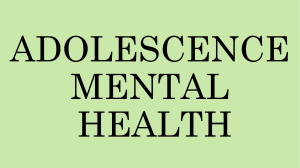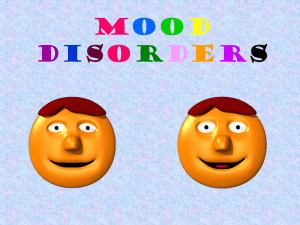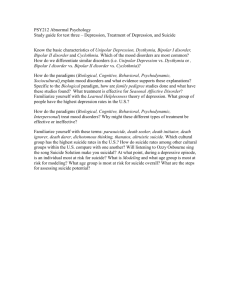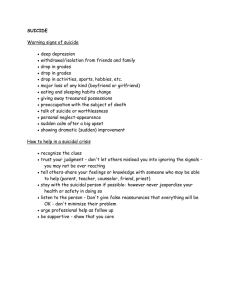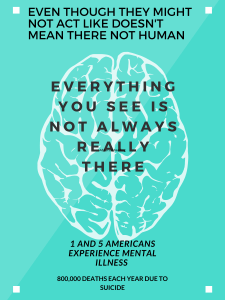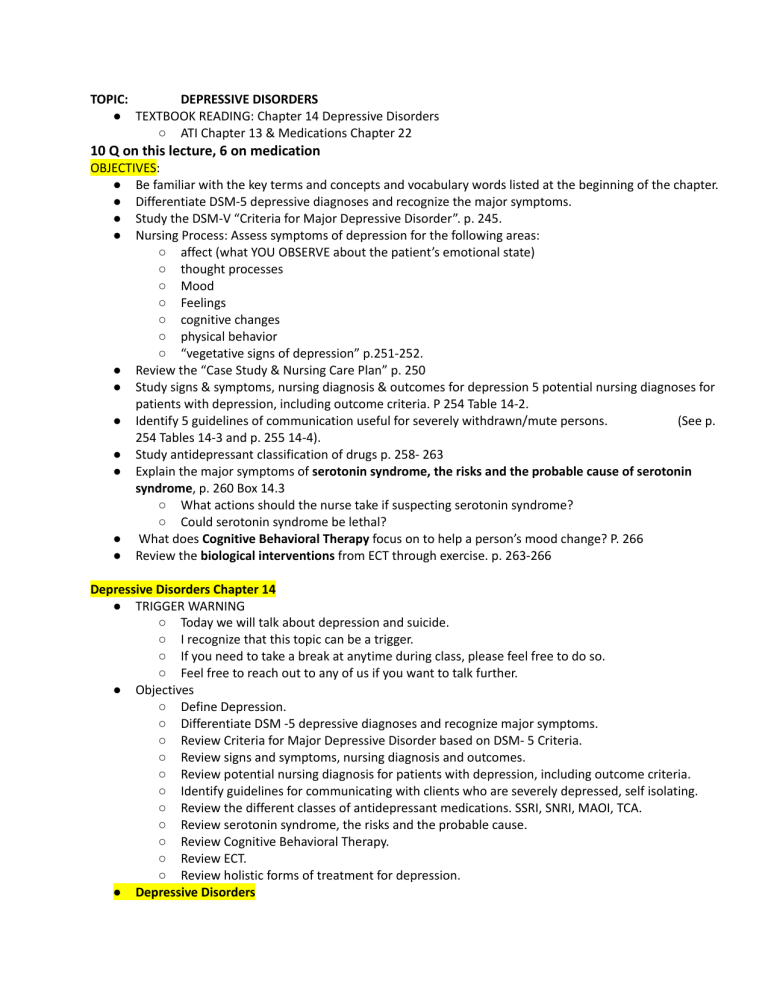
TOPIC: DEPRESSIVE DISORDERS ● TEXTBOOK READING: Chapter 14 Depressive Disorders ○ ATI Chapter 13 & Medications Chapter 22 10 Q on this lecture, 6 on medication OBJECTIVES: ● Be familiar with the key terms and concepts and vocabulary words listed at the beginning of the chapter. ● Differentiate DSM-5 depressive diagnoses and recognize the major symptoms. ● Study the DSM-V “Criteria for Major Depressive Disorder”. p. 245. ● Nursing Process: Assess symptoms of depression for the following areas: ○ affect (what YOU OBSERVE about the patient’s emotional state) ○ thought processes ○ Mood ○ Feelings ○ cognitive changes ○ physical behavior ○ “vegetative signs of depression” p.251-252. ● Review the “Case Study & Nursing Care Plan” p. 250 ● Study signs & symptoms, nursing diagnosis & outcomes for depression 5 potential nursing diagnoses for patients with depression, including outcome criteria. P 254 Table 14-2. (See p. ● Identify 5 guidelines of communication useful for severely withdrawn/mute persons. 254 Tables 14-3 and p. 255 14-4). ● Study antidepressant classification of drugs p. 258- 263 ● Explain the major symptoms of serotonin syndrome, the risks and the probable cause of serotonin syndrome, p. 260 Box 14.3 ○ What actions should the nurse take if suspecting serotonin syndrome? ○ Could serotonin syndrome be lethal? ● What does Cognitive Behavioral Therapy focus on to help a person’s mood change? P. 266 ● Review the biological interventions from ECT through exercise. p. 263-266 Depressive Disorders Chapter 14 ● TRIGGER WARNING ○ Today we will talk about depression and suicide. ○ I recognize that this topic can be a trigger. ○ If you need to take a break at anytime during class, please feel free to do so. ○ Feel free to reach out to any of us if you want to talk further. ● Objectives ○ Define Depression. ○ Differentiate DSM -5 depressive diagnoses and recognize major symptoms. ○ Review Criteria for Major Depressive Disorder based on DSM- 5 Criteria. ○ Review signs and symptoms, nursing diagnosis and outcomes. ○ Review potential nursing diagnosis for patients with depression, including outcome criteria. ○ Identify guidelines for communicating with clients who are severely depressed, self isolating. ○ Review the different classes of antidepressant medications. SSRI, SNRI, MAOI, TCA. ○ Review serotonin syndrome, the risks and the probable cause. ○ Review Cognitive Behavioral Therapy. ○ Review ECT. ○ Review holistic forms of treatment for depression. ● Depressive Disorders ○ ● Major Depressive disorder- MDD with specifiers ■ Specifiers: With or without psychotic features ○ Persistent depressive disorder ○ Postpartum Depression ○ Premenstrual dysphoric disorder ○ Substance/medication induced depression ○ Depressive disorder due to another medical condition ○ Common Comorbidities ■ Anxiety Disorders (70%) ■ Psychotic Disorders ■ Substance Use Disorders (usually used for coping) ■ Eating Disorders ■ Personality Disorders ■ (These disorders will be discussed further in upcoming lectures.) ○ What is Depression ? ■ Commonly referred to as Major Depressive Disorder or clinical depression. ■ Depression is a mood disorder that is a widespread issue, ranking high among the causes of disability. (ATI Ebook) ■ Effects your mood, feelings and attitude. ■ Results in significant change to a client’s normal functioning i.e. social, occupational and self-care. ○ Risk Factors ■ Genetic- first degree relative= higher chances ■ Hormonal= sudden shift in hormones ■ Biochemical ■ Three main neurotransmitters involved in mood are serotonin and norepinephrine and dopamine ■ Diathesis-Stress Model= genetics + life events (stress) ● Depression can be caused by the nature-nurture balance Major Depressive Disorder (Clinical Depression) ○ Diagnosis- Criteria from DSM V ○ Must have one in red and overall, 5 of 9 Symptoms most of the day, nearly every day for a minimum of 2 weeks. ■ Depressed mood ● In the last 2 weeks: have you been in a depressed mood? ■ Low energy (anergia) ● In the last 2 weeks: have you experienced low energy? ■ Low interest/pleasure (anhedonia) ■ Weight loss or gain (5% of total body weight over 1 month) ■ Insomnia or hypersomnia ● No sleep or too much sleep ■ Psychomotor agitation or retardation ■ Feelings of worthlessness/guilt ■ Decrease in concentration ■ Thoughts of death or suicide ● Thoughts w/ or w/o plan ● Suicide attempts ○ Additional Criteria for MDD ■ ■ ○ ● ● ● Causes impairment in social and/or occupational functioning. Episode not due to a medical condition. ● Medical condition must be ruled out before diagnosis. If symptoms are caused by medical condition then that is what is treated ■ Never a manic or hypomanic episode (this will be considered Bipolar disorder) MDD is the most common diagnosis on charts for INSURANCE purposes ■ Chart vs client presentation and notes ← will show a better picture Post Partum Depression ○ Depressive episode that begins within 4 weeks of childbirth. ○ Safety risk for mother and baby. ○ Potential Causes: ■ Hormonal changes ie estrogen and progesterone ■ Abrupt changes in lifestyle ● This explains why it can happen in men. ● The self absorbed ones Persistent Depressive Disorder (formerly known as dysrhythmic disorder) (You may see MDD over PDD at the BMC due to insurance issues) ○ Milder form of depression. ○ At least 3 clinical findings of depression. ○ Can develop into MDD later in life. ○ Usually has an early onset during in childhood or adolescents. ○ Last at least 2 years for adults, 1 year for children. ○ Don’t diagnose your friends/self, even when it’s true Premenstrual Dysphoric Disorder (PMDD) ○ Associated with the luteal phase of the menstrual cycle (7-10 days before bleeding). ○ Mood swings, irritability, depression, anxiety, feeling overwhelmed and difficulty concentrating, anergia, overeating, hypersomnia or insomnia, breast tenderness, aching, bloating, and weight gain ■ Lack of information has led to many women feeling they have mental illness. Remember → Rule out medical conditions first! This is a hormonal imbalance, not mental illness. ○ Impairs day to day functioning and interactions. 🙄🙄🙄 ● ● ○ Symptoms usually subside once bleeding begins. ○ Effects 2-6% of menstruating clients. Substance/Medication-Induced Depressive Disorder ○ Clinical findings of depression associated with the use of, or withdrawal from drugs or alcohol. ○ Dopamine drugs/medications change receptors, increase baseline levels. Can occur during use and/or withdrawal Seasonal Affective Disorder ○ Form of depression that occurs seasonally. ○ Usually during the winter, when there is less daylight. “winter blues” ■ Low light areas like Seattle in the winter have correlation studies that link sunlight to depression exacerbation ○ Treatment: Light Therapy (discussed more towards the end of lecture) ■ Theory: helps to increase chemicals in the brain that help with depression. ■ Increases levels of serotonin from light exposure ● Client Care ○ Admission to BMC requirements ■ Danger to self, others, gravely disabled ○ Acute phase: Severe clinical findings of depression ■ Potential need for inpatient mental health due danger to self. ■ Medication, group therapy. ● ● ● ● 1:1 is ideal but due to strain on system it is mostly group ■ Assess: Suicide risk ● #1 urgency and focus ● Always assess for safety ● Self-harm, attempt, or plan for suicide ■ Goal: Client no longer a danger to self, participates in self care and has resources to promote safety outpatient. ● Self care in particular is usually the first skill to stop, exacerbates withdrawal from social situations ○ Continuation phase: ■ Care: Medications and psychotherapy ● Medicate from a few months to life ■ Goal: prevent relapse ○ Maintenance: Remission of symptoms ■ Prevention of future clinical depressive episodes. ■ Consider: ● How long do clients have to be on medications for? ○ Everyone is different ● How long will they need to be in therapy? ○ Everyone is different ○ Therapy tends to extend past medication ● Will the client be sad again? ○ Yes. It’s about giving them the resources to cope in healthy ways ■ Remember: Life happens, people will be sad, but the goal is for the sadness not to reach clinical depression which hinders occupational and/or social functioning or can lead to client becoming a danger to self, danger to others or gravely disabled. Additional Risk Factors ○ Highest rates: ■ More common in females than males (2:1) ■ Ages 18-25 ■ Medical disorders with poor prognosis ● Depression is not prioritized in pts with severe chronic disease ■ Individuals who reported being multiracial (2 or more races); NIMH (2020) ■ Older adults age >65 ● Risk for depression increases as health deteriorates Expected Findings for MDD ○ Anergia ○ Anhedonia ○ Anxiety ○ Psychomotor agitation (restless, inability to sit still) or psychomotor retardation (sluggish, slumped posture) ○ Vegetative Findings: change in eating patterns, change in bowel habits, sleep disturbances. Additional findings ○ Slowed speech, delay in responses ○ Poor grooming or lack of hygiene ○ Socially isolating ○ Client may lack energy to engage in groups or complete tasks. ■ ● ● ● ● ● ● They can be easily overwhelmed, assess and accommodate decreased energy and tolerance. Small increments will increase compliance Screening Tools (be visually familiar with these) ○ Hamilton Depression Scale ○ Beck Depression Inventory ○ Geriatric Depression Scales ○ Zung Self- Rating Depression Scale ○ Patient Health Questionnaire-9 (PHQ-9) Nursing Care ○ Suicide risk: Assess risk for suicide and implement safety precautions. ○ Self-care: Monitor client’s ability to perform ADL’s. Encourage client to partake in ADL’s even if they do not feel like it. Promote independence with ADL’s. ○ Communication: ■ Make time to speak with client, even if they do not engage. ■ Give directions in short, concrete statements. Why? They may lack extended focus, delayed auditory processing, and need simple direct communication that does not need high level of thought or processing ■ Break up tasks in short increments of time. Why? It makes the task less overwhelming for them ■ Give the client time to respond to questions. Why? They may have slower processing and need more time to find the words to communicate Treatment ○ Pharmacological ■ SSRI ■ SNRI ■ MAOI ■ TCA ○ Non-Pharmacological (covered later) ■ Diet ■ Exercise ■ Psychotherapy ie CBT ■ ECT Tips for studying psychotropics ○ Know which neurotransmitter is being manipulated ie increased or decreased. ○ For exams you will be given drug name and class. ■ Study by class and know the difference, UNLESS something is specific to a specific medication. ○ ATI only gives generic name. ○ Use ATI templates to organize information in class. Neurotransmitters ○ Signaling molecules (dopamine, serotonin, norepinephrine) that are released by one neuron and received by receptors of another neuron. ○ This process relays a message from one neuron to the next. ○ This is thought to regulate mood, attention, sleep and cognition. ○ The amount of neurotransmitters present in between a synaptic cleft is theorized to effect symptoms of depression. ■ Lack of neurotransmitters means the messages aren’t getting sent Dopamine ● ● ● ● ○ Helps with attention, motivation and pleasure. ○ Too high? Excess energy, mania, euphoria, impulsivity. ○ Too low? Depression, low energy, low motivation. Serotonin ○ Helps with regulation of sleep, pain perception, mood states, temperature, regulation of aggression, libido, precursor for melatonin ○ Found mostly in the GUT ■ 80% ■ This is why diet and mental health are so connected ○ Too little? Irritability, hostility, depression, sleep regulation, loss of appetite, loss of libido ○ Too much? Increased aggression, serotonin syndrome Norepinephrine ○ Helps with alertness, focused attention, orientation, primes “fight or flight”, learning and memory. ○ Too little? dullness, low energy, depressive affect ○ Too much? Anxiety, hyper alertness, increased startle, paranoia, decreased appetite Selective Serotonin Reuptake Inhibitors (SSRIs) ○ First-line medication treatment for MDD ■ Increases Serotonin in the synaptic cleft ■ Least amount of side effects ○ Generic names: fluoxetine (Prozac), sertraline (Zoloft), citalopram (Celexa) ○ Neurotransmitter: Serotonin ○ MOA: Block the reuptake of serotonin; increases availability of serotonin in the synaptic cleft ○ Side effects: GI issues (n/v) (why?), agitation, anxiety, sleep disturbance, sexual dysfunction, headache ■ 80% of serotonin receptors are in the gut, sudden mediation increases will have high GI issues ○ Adverse side effects: Serotonin Syndrome and Serotonin Discontinuation Syndrome (will discuss more in future slides) ○ Education: ■ Can take up to 4-6 weeks to see the best effects of the medication ■ Partaking in self care activities are usually the first indicators of improvement Serotonin Norepinephrine Reuptake Inhibitors (SNRIs) ○ Generic Names: duloxetine (Cymbalta), venlafaxine (Effexor) ○ MOA: Inhibit reuptake of both serotonin and norepinephrine ○ Common side effects: similar to SSRIs; but SSRIs tolerated better (why?) ○ Adverse side effects: same as SSRI plus can worsen anxiety, sweating ○ Caution when giving to clients with hypertension, why ? ● Tricyclic Antidepressants (TCAs) ○ Generic names: amitriptyline (Elavil) ○ MOA: Inhibit reuptake of norepinephrine and serotonin ○ Note: TCA’s also blocks histamine. ○ Side effects - Blocks histamine; sedative effect, similar to anticholinergics (ie dry mouth, constipation, urinary retention). ○ ○ ● Education: Chewing sugarless gum, eat food high in fiber, increase fluid intake can help alleviate side effects. Adverse Side Effects: cardiovascular issues- dysrhythmias, tachycardia, myocardial infarction 💓💘💤😴🛌❤ ○ ○ High risk for older adults and patients w/ cardiac disease Monoamine Oxidase Inhibitors (MAOIs) ○ 2 0r 3 questions, focus on hypertensive crisis ○ Generic names: Phenelzine (Nardil) ○ MOA: Increase serotonin, norepinephrine and dopamine. ○ Common side effects: dry mouth, nausea, diarrhea or constipation, insomnia and drowsiness ■ Has a STRICT diet restriction ○ Adverse side effects: Hypertensive Crisis ○ Education: Cannot take other serotonin enhancing drugs while on MAOIs or leads to Serotonin syndrome. ○ MAOI and Hypertensive Crisis: ■ Patients taking MAOI need to have a tyramine free diet ■ Byproduct of the metabolization of MAOI’s= increase in tyramine ■ Tyramine increases risk for elevated blood pressure= hypertensive crisis!! (explained on next slide) ■ Avoid foods with tyramine and instead eat FRESH FOODS ● Avoid: Aged, fermented, tofu, avocado, banana, wine, processed meat and cheese ○ Hypertensive Crisis ■ Hypertensive crisis occurs within 15 to 90 minutes of ingestion of contraindicated substances ■ Early signs- Irritability, anxiety, flushing, sweating, severe headache ■ Anxious, restless, fever ■ Severe fever, seizures coma ■ Medical emergency ■ Medical emergency ■ Stop medication ■ Seek medical attention ■ Serotonin Syndrome ■ Greatest risk factor is combining multiple antidepressants or taking more than prescribed. ● Especially MAOI and TCA combination ● Serotonin Syndrome – CAN OCCUR WITHIN HOURS OF INCREASING SEROTONIN ○ LIFE-THREATENING ■ High Temp ^107 Diaphoresis - Excessive sweating; being “soaked” ■ Confusion. ■ Agitation or restlessness. ■ Dilated pupils. ● ● ● ● ● ● ■ Headache. ■ Changes in blood pressure and/or temperature. ■ Rapid heart rate. ■ Nausea and/or vomiting. ■ Diarrhea ○ Serotonin Syndrome Interventions (box 14.3) ■ Stop medication ■ Seek medical help immediately Serotonin Withdrawal Syndrome not fatal ○ “finish” = Withdrawal Symptoms - Occurs 2-5 days after last dose ○ NEVER STOP DRUG ABRUPTLY ■ F = Flu-like symptoms (headache, visual disturbances, anxiety, tremors) ■ I = Insomnia (with vivid dreams or nightmares) ■ N = Nausea and/or vomiting ■ I = Imbalance (dizziness, vertigo, lightheaded) ■ S = Sensory disturbances ("burning" "tingling""electric-like" shock-like ZAPS sensations) ■ H = Hyperarousal (anxiety, irritability, agitation, aggression, mania, jerkiness) ○ Pt. NEEDS TO GO BACK ON MED & TAPER DRUG VERY SLOWLY. Treatment ○ Non-Pharmacological ■ Diet ■ Exercise ■ Psychotherapy ie CBT ■ ECT Exercise ○ Releases endorphins and neurotransmitters ○ Releases body temperature which can help relax tense muscles ○ Suggested to exercise 20 min x 3/week Diet ○ Less processed foods ○ More fruits and vegetables ○ Omega-3 ■ Commonly found in fish oil and marine algae ■ Contains two fatty acids known as DHA and EPA Researchers found that people with depression and anxiety have lower levels of DHA and EPA Ask about…St. John’s Wort ○ Used to help with depression, anxiety and menopause symptoms ○ Herbal supplement ○ Acts on neurotransmitters to improve mood ○ In America, its OTC, not FDA approved ■ Some countries have this banned due to the interactions with prescription mediations ○ Can cause serotonin syndrome when used with other antidepressants. Light Therapy ○ First-line for seasonal affective disorder (SAD) ○ Helps to boost neurotransmitters to help with depression. ○ Possible side effects: Headache and jitteriness ■ Increases serotonin ● ● ● ● ● ● ● ● Electroconvulsive Shock Therapy ○ https://www.youtube.com/watch?v=-T0mwzXHgvI 9 min. ○ Indication: drug-resistant depression ○ Seizure-induced therapy ○ Nursing Safety Concerns and Interventions: ○ Anesthetic and paralytic drugs given before ECT ○ Retrograde amnesia (loss of memory leading up to, including treatment) ○ Risk for fall afterwards ○ Can be confused for several hours after procedure Therapy ○ Individual ○ Interpersonal therapy ○ Cognitive behavioral therapy ■ Aaron Beck-noticed that people with depression thought differently than those not depressed: ■ Patterns of negative and self-critical thinking ■ Distorted ability to think and process ■ CBT challenges the negative thoughts ■ Automatic thoughts/cognitive distortions- rapid, unthinking thoughts that are intense and irrational; leads to misinterpretations ■ Goal is to identify negative thinking and challenge pessimistic thoughts ■ Patients will challenge their negative thinking and replace with positive and rational thinking ■ CBT is gaslighting yourself into being okay Chapter 14 Vocabulary ○ affect ○ anergia ○ anhedonia ○ bereavement exclusion ○ deep brain stimulation ○ electroconvulsive therapy (ECT) ○ light therapy ○ repetitive transcranial magnetic stimulation (rTMS) ○ serotonin syndrome ○ suicidal ideation ○ vagus nerve stimulation ○ vegetative signs of depression Key points Children and adolescents with disruptive mood dysregulation disorder had previously been diagnosed with bipolar disorder. Usually, children with this disorder grow up and are diagnosed with major depressive disorder or an anxiety disorder. Persistent depressive disorder is a low-level depression that tends to be chronic. Treatment for this disorder is similar to major depressive disorder. Premenstrual dysphoric disorder is diagnosed for women with physical discomfort and emotional symptoms similar to major depression. These symptoms disappear at the onset of menstruation. The symptoms of major depressive disorder are usually severe enough to interfere with a person’s social or occupational functioning. A person with depression may or may not have psychotic symptoms. The most severe consequence of major depressive disorder is suicide. ● ● ● ● ● ● ● Many theories exist about the cause of depression. Biochemical abnormalities are strongly supported in the scientific community. The diathesis-stress theory suggests a dynamic interaction between psychosocial stressors and interpersonal events with neurochemical changes in the brain. Nursing assessment includes the evaluation of affect, thought processes (especially suicidal thoughts), mood, feelings, and physical behavior. The nurse also must be aware of the symptoms that may mask depression. Nursing diagnoses are numerous. Risk for suicide is always the priority diagnosis when suicidal ideation is present. Other common nursing diagnoses are chronic low self-esteem, imbalanced nutrition, constipation, disturbed sleep pattern, ineffective coping, and disabled family coping. Interventions include using specific principles of communication, planning activities of daily living, administering or participating in psychopharmacological therapy, maintaining a therapeutic environment, and teaching patients about the biochemical aspects of depression. Depression is often overlooked in children, adolescents, and older adults. Planning and interventions for patients with depression are based on the recovery model, which involves a therapeutic alliance with healthcare professionals to achieve outcomes based on individual patients’ needs and values. Evaluation is ongoing throughout the nursing process, and patients’ outcomes are compared with the stated outcome criteria and short-term and intermediate indicators. The care plan is revised when indicators are not being met. TOPIC: SUICIDE PREVENTION AND NON-SUICIDAL SELF-INJURY ● TEXTBOOK READING: Chapter 25 Suicide and Non-Suicidal Self-Injury ■ ATI Chapter 30 OBJECTIVES: ● Be familiar with concepts and vocabulary words listed at the beginning of the chapter. ● Identify three common precipitating events for suicide attempts. ● Describe risk factors for suicide, including coexisting psychiatric disorders. ● Be able to use the “Suicide Assessment” Skill #8 in the LLUSN NRSG 217 clinical syllabus in the Communication Skills section. ● Give examples of primary, secondary, and tertiary interventions. ● Describe basic-level interventions that take place in the hospital or community. ● Identify key elements of suicide precautions and environmental safety factors in the hospital. See p. 484 Table 25.3 ● How does non-suicidal self-injury differ from suicide? ● Consider the clinical significance of a depressed client whose mood rapidly changes from sad or depressed to happy and peaceful in a short amount of time? What could that indicate? Suicide and Non Suicidal Self-Injury Chapter 25 https://www.youtube.com/watch?v=W6T9GA4lyBg ● How do We Talk About Suicide? ○ Avoid using “commit” or “committed” (implies person did something wrong) ○ Avoid saying “completed suicide” (implies something was successful) ○ Instead use: “died by or of suicide” or “took their own life” ● Terms ○ Suicidal ideation ■ thinking about personal death ■ wish to be dead ■ considering methods of accomplishing death ○ ● ● ● ● ● ■ Creating plan to carry out attempt Suicide Attempt- carrying out an act or acts with the intention of death, which may or may not prove fatal Suicide- intentional act of killing oneself by any means; results in death ○ Suicide ○ 10th leading cause of death in the US. ○ In 2019, 47,511 Americans died by suicide. ○ In 2017 there were 1.38m suicide attempts. ○ (Centers of Disease Control and Prevention, CDC, 2021) Biological Risk Factors ○ Low levels of serotonin in those who are suicidal ○ JUST FYI…there are certain gene expressions that are being studied that are showing a risk for suicide Communities with Higher Rates of Suicide ○ Native Americans/Alaska Natives ■ Generational trauma ■ Lack of access ○ Individuals in justice and child welfare settings ○ Individuals who engage in non suicidal self-injury (NSSI) ○ Individuals with mental and/or substance use disorders ■ Numb or escape, but drug becomes ineffective ○ Lesbian, gay, bisexual, and transgender (LGBT) populations ■ Isolation, stigma, bully ○ Men ages 25-45 and 65+ ○ Previous Suicide Attempt/Sexual Assault ○ Nurses ■ Work trauma and experience ■ cPTSD ■ Lack of self-care or self-prioritizing SAD PERSONS are at a higher risk ○ Sex (male) ○ Age 25-44 or 65 + ○ Depression ○ Previous attempt ○ Ethanol use ○ Rational thinking loss or IRRational thinking ○ Social support lacking or recent loss ○ Organized plan ○ No spouse ○ Sickness Suicide Methods ○ Higher-risk methods, also referred to as hard methods, include: ■ Using a gun ■ Jumping off a high place ■ Hanging ■ Poisoning with carbon monoxide ○ Examples of lower-risk methods, also referred to as soft methods, include: ■ Slashing one's wrists ● ● ■ Inhaling natural gas ■ Ingesting pills Mental Illness and Suicide ○ Depression- most associated with suicide ○ Patients diagnosed with anorexia nervosa and posttraumatic stress disorders are at greater risk for suicide ○ Schizophrenia- eight-fold increase than those of the general population ○ About 13% of schizophrenics people with schizophrenia die from suicide ○ Substance use disorders have higher suicide risk Nursing Interventions ○ Focus on prevention, treatment and postvention ○ Primary intervention- provides activities, support and education to prevent suicide. Can be done in community settings ie schools, homes, churches, clinics, hospitals and work settings. ○ Assess for hopelessness; most predictive emotion connected to suicide risk ○ See Box 25.3 pg. 482 in textbook ○ Teach coping skills, stress management and communication skills ○ Develop safety plan and include family or significant others ○ Goal for discharge is that patient will be free of self-inflicted harm; thoughts, plan and actions ● ● ● ● ● ● Suicide precautions in hospital ○ Search patient for harmful items ○ Remove potentially harmful objects from pt’s belongings ○ One-to-one observation (patient observed within arm’s length) AT ALL TIMES, why? ○ Chart whereabouts, mood and behavior per protocol ○ No glass or metal silverware on meal trays ○ Observe during medication administration (mouth checks) ○ Take potentially harmful gifts from visitors ○ Assessment of suicidal risk is ONGOING ○ Documentation ○ See box 25.4, pg. 484 Verbal and Nonverbal Cues ○ Overt (shown openly; manifested) Statements ■ “Life isn’t worth living anymore.” ■ “I wish I were dead.” ■ “Everyone would be better off if I died.” ○ Covert (not openly shown or acknowledged) Statements ■ “It’s okay now. Soon everything will be fine.” ■ “Things will never work out.” ■ “I won’t be a problem much longer.” ■ “Nothing feels good to me anymore and probably never will.” ■ “How can I give my body to medical science?” Specific Questions to ask about SI ○ Have you ever felt that life was not worth living? ○ Have you been thinking about death recently? ○ Do you ever think about suicide? ○ Have you ever attempted suicide? ○ Do you have a plan for completing suicide? ○ If so, what is your plan for suicide? ○ Ask patient if they are suicidal if they say something that raises level of concern. ■ Nurse: How are you feeling today? Pt: I don’t care, nothing matters, why did I even wake up this morning? Nurse: Are you feeling suicidal? REMEMBER: Asking about suicidal thoughts DOES NOT USUALLY give a person the idea to attempt suicide. ○ Talking brings RELIEF! Consider… ○ 1) SI or SI with intent ○ 2) Specific plan ○ 3) Access to means to carry out a plan Assessment ○ Assessment tools provide baseline evaluation that provide comparison over time ○ Suicide Assessment Five-Step Evaluation and Triage (SAFE-T) (encompasses both risk and protective factors) ○ Assists in benchmarking risk (low, moderate, high) and development a treatment plan ● ● ● Importance of Postvention after Death by Suicide ○ Support for surviving friends and family ■ Subject of suicide can be taboo ■ Guilt, shame, sadness, loneliness, disbelief ■ Adolescents are more likely to report SI within 6 years ■ Family members are 4.5 times more likely to have SI ○ Recent study findings: ■ Bereaved adults by suicide are more likely to attempt suicide ■ Effect of suicide bereavement is similar, blood-related or not Postvention Reminders ○ Provide empathy ○ Ask open-ended questions ○ Talk about deceased person ○ Reach out during difficult anniversary dates ■ Physiological symptoms may present without conscious awareness of anniversary ○ Recommend community resources and support groups Non suicidal Self Injury ● ● ● ● ○ cutting or severely scratching skin ○ burning or scalding ○ hitting self or banging head ○ punching things or throwing your body against walls and hard objects ○ sticking objects into skin ○ intentionally preventing wounds from healing ○ swallowing poisonous substances or objects ○ Distraction from emotional pain with infliction of physical Talking with a PT with non-suicidal self injuries ○ Ask pt. how cutting etc. seems to help them. ○ Ask: Would you show me your cuts? ○ Do you cut other places on your body? ■ “How does cutting help you?” ■ “What do you get from cutting?” ■ “Can you show me the location of your cutting?” ● Sexual areas indicates sexual assault ○ Where? --it could be trunk, thighs, bottom of feet. These areas generally are considered more serious level of cutting. Make sure you tell nurse if you learn of other areas. The nurse may know because they do skin checks. ○ Are there certain triggers where you end up cutting yourself? ( Do not say “Triggers that MAKE YOU cut.” Worded that way removes power from trigger) Nursing Interventions ○ Care for wounds and injuries ○ Therapeutic alliance ○ Teach coping skills ○ Psychotherapy/Group therapy ○ Treat underlying psychiatric disorders w/ medication ○ Evaluation is ONGOING Resources ○ National Suicide Prevention Lifeline ○ Call 1-800-273-TALK (8255) 24/7, Free support! suicidepreventionlifeline.org ○ San Bernardino County Behavioral Health Member services:24/7 Access and Referral Helpline: 1-888-743-1478 ○ In a crisis, but don’t need 911? Call 909-336-8256 ○ suicideispreventable.org ○ Dial 2-1-1 or visit www.211sb.org○ San Bernardino Resource Hub ○ LLU - ACE & Instructors Chapter 25 Vocabulary ○ cluster suicide ○ lethality ○ nonsuicidal self-injury (NSSI) ○ postvention ○ primary intervention ○ psychological autopsies ○ suicidal ideation ○ suicide ○ suicide attempt ○ suicide survivors Key points ● Suicide is a significant public health problem in the United States and should be approached as a “never event.” ● Specific biological, psychosocial, and cultural factors increase the risk of suicide. ● Treating the coexisting psychiatric disorder may help most patients with suicidal ideation. ● Certain health conditions and psychiatric diagnoses are associated with increased risk for suicide. ● Every suicide attempt must be taken seriously even if the person has a history of multiple attempts. ● Nursing care of the patient who is suicidal is challenging but rewarding. Patients’ desperate feelings evoke intense reactions in staff, but most people with suicidal behaviors respond to treatment and do not end their life by suicide. ● If a patient dies by suicide, family, friends, and healthcare workers are traumatized and need postvention, including support, understanding, and possibly including referrals for psychiatric treatment. ● NSSI is a problem that is becoming increasingly important, especially among young people. ● Social contagion of NSSI is a serious implication in the spread of this compulsive behavior. ● Treatment for self-injurious behaviors includes a supportive therapeutic relationship, adopting alternate coping methods, medication, and psychotherapy, such as dialectical behavior therapy.
